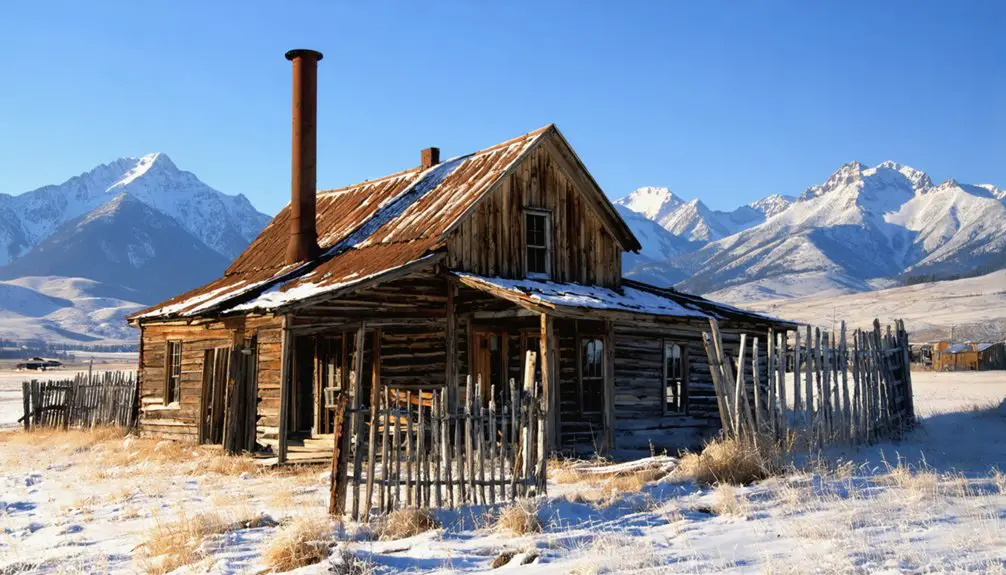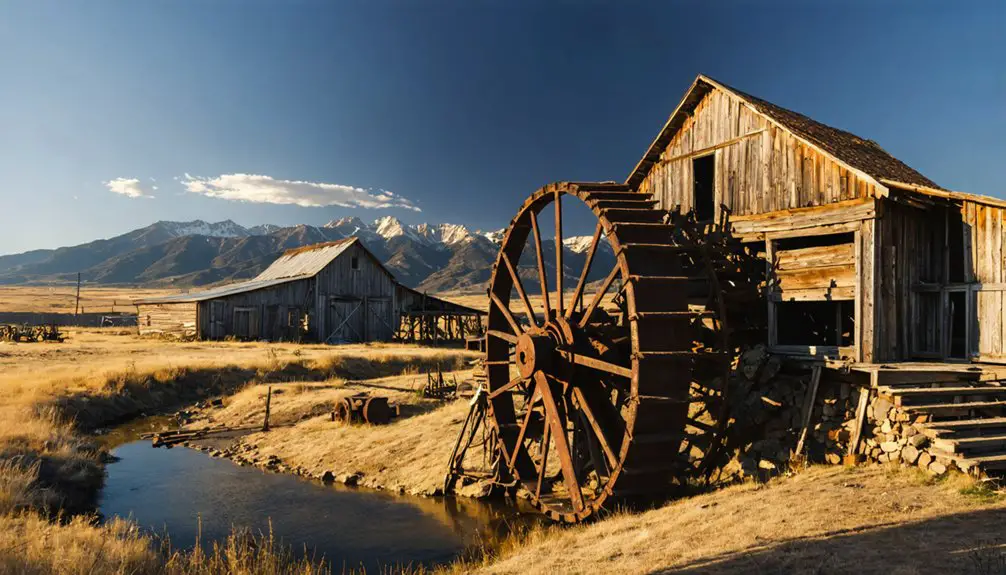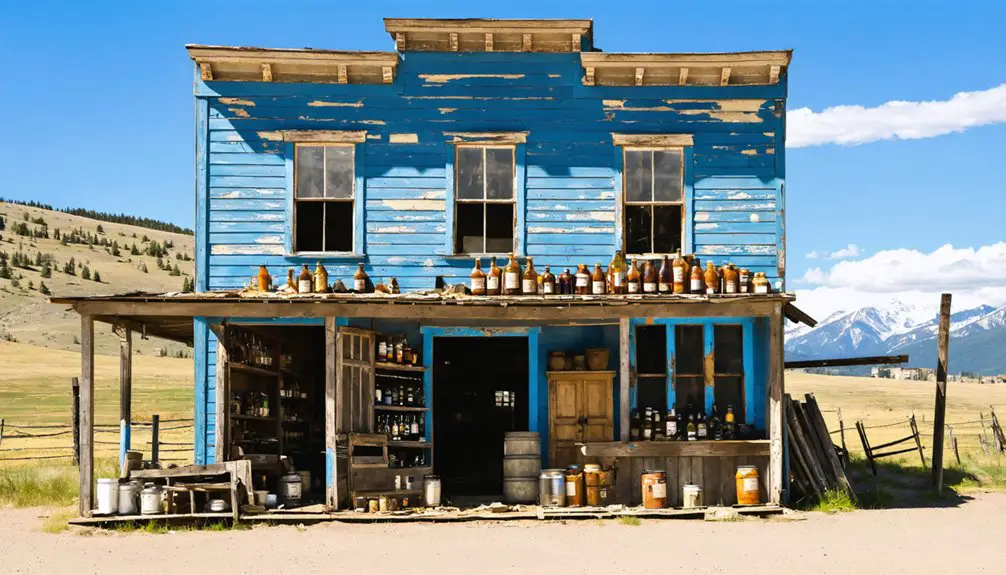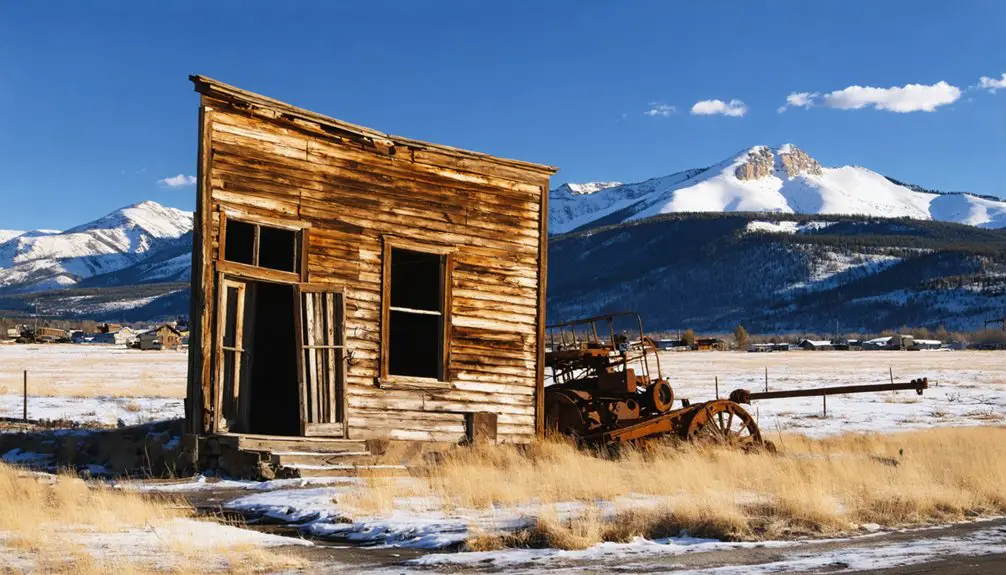You’ll find the ghost town of Bighorn, Montana nestled in the state’s mining frontier, where prospectors first struck gold in the 1860s across 500 gulches. The town boomed with mining camps and heavy machinery until 1896, when poor gold quality forced operations to cease. By 1903, settlers transformed the abandoned mining claims into successful ranches, repurposing infrastructure and establishing water systems. The site’s preserved buildings and artifacts reveal a fascinating evolution from mining dreams to ranching reality.
Key Takeaways
- Bighorn began as a bustling gold mining settlement in the 1860s but declined by 1896 when mining operations proved unprofitable.
- Abandoned mining equipment and half-built sawmills remain as evidence of the failed gold mining ventures in the area.
- Former mining claims and infrastructure were repurposed for ranching and agriculture by 1903 as settlers adapted to new opportunities.
- The Yellowtail Dam’s construction in 1967 transformed the landscape, creating Bighorn Lake and shifting the region’s economic focus.
- The National Park Service now preserves the ghost town’s historic structures and offers self-guided trails for visitors to explore.
The Birth of a Mining Dream
As gold discoveries swept through Montana’s gulches in the early 1860s, the area that would become Bighorn emerged as a promising mining frontier.
You’d find prospectors establishing claims across nearly 500 gulches, driven by the allure of exceptionally large nuggets weighing up to 4.5 ounces – noticeably bigger than typical Montana finds.
The rush intensified when Congress set a deadline in 1874 for miners to actively work their claims or lose them. Native Crow and Cheyenne tribes fiercely defended their ancestral lands as prospectors continued to encroach deeper into their territory.
You can trace how mining camps quickly sprouted wherever gold surfaced, transforming untamed landscapes into bustling communities. The area contributed significantly to the local economy through mining and logging operations at the turn of the 20th century.
The Bozeman Trail, blazed in 1863, became your lifeline to these remote treasures, connecting through the Bighorn River valley and allowing wagon trains to penetrate deeper into Montana’s gold-rich territory.
From Gold Rush to Ranch Life
You’ll find stark evidence of fading mining dreams in the abandoned machinery and half-built sawmills that dot the Bighorn landscape from the 1890s.
Like many Western mining ventures, these operations struggled with transportation costs that made extracting and shipping ore unprofitable.
Health seekers were drawn to the area’s low sickness rates, though the harsh climate eventually discouraged permanent settlement.
By 1903, you can trace how settlers adapted to ranch life as they repurposed mining infrastructure, transforming tunnels into storage spaces and using old water management systems for livestock.
The pioneering spirit lived on as ranchers established new water distribution networks, drawing from the same springs and streams that once served the mining operations.
Mining Dreams Fade Away
While initial hopes ran high during the 1891 gold strike, Bald Mountain City‘s mining dreams began fading by late 1896 when mining engineer Fred D. Smith exposed the exaggerated nature of the gold claims.
You’d have seen mining techniques evolve from simple placer operations to more complex endeavors as the Fortunatus Mining Company poured half a million dollars into the venture.
The economic challenges proved insurmountable. You would’ve watched as miners struggled with the fine, thinly spread gold deposits that made both placer and lode mining inefficient. The area’s geological composition, like the nearby Bighorn Mountains, was not typically conducive to gold mining.
Even hauling in heavy machinery by ox team in 1895 couldn’t save the operation. Despite sporadic mining continuing until 1903, the gold’s poor quality and scarcity ultimately forced miners to abandon their claims, leaving behind empty buildings and broken dreams. Many prospectors instead chose to follow the safer Bridger Trail to seek their fortunes in more promising Montana gold fields.
Adapting to Ranch Life
Once the mining economy faltered in 1903, former prospectors began transforming Bighorn’s economic landscape through cattle ranching.
The fur trade decline ultimately influenced locals to seek more sustainable ventures in ranching and agriculture.
You’d find these resilient pioneers adapting mining claims into grazing lands, learning ranching techniques from experienced cattlemen, and establishing permanent homesteads where temporary camps once stood.
The shift to ranch life brought three major changes:
- Implementation of strategic fencing and irrigation systems
- Development of sustainable livestock management practices
- Integration of crop farming alongside cattle operations
You can still see remnants of this change today, where ranch infrastructure replaced mining equipment.
The newcomers mastered water management, adopted dry farming methods where possible, and created lasting connections to railroad networks.
This adaptation didn’t just change the land – it transformed Bighorn’s identity from a boom-and-bust mining town to a stable ranching community.
Pioneering Water Management Systems
Three major water management projects transformed Bighorn’s evolution from mining camp to ranching community.
First, you’ll find the Bighorn Canal system, initiated in 1896, which redirected 720 cubic feet per second of water through a 416-foot diversion dam. This pioneering irrigation technique supported 35,000 acres of farmland by 1904.
Next, you’ll discover the extensive network of manually operated canals and headgates that the Crow Tribe developed, marking their shift from hunting to farming. The development provided vital flood control and irrigation water for the surrounding communities.
These water rights negotiations shaped the region’s agricultural future.
Finally, there’s the Yellowtail Dam, constructed between 1961-1967, which revolutionized water management with its 1.38 million acre-feet reservoir capacity. The dam spans 72 miles into Wyoming, creating Bighorn Lake and fundamentally altering the region’s landscape.
This concrete arch dam not only provides irrigation but also generates 250 MW of hydroelectric power, fundamentally changing Bighorn’s ranching economy.
Living Legacy of the Ewing/Snell Ranch
Since its establishment in 1896, the Ewing/Snell Ranch has stood as a tribute to pioneer resilience in Montana’s challenging Dryhead Country.
You’ll find this cultural heritage site now preserved within the Bighorn Canyon National Recreation Area, where it continues to tell the story of frontier adaptation and ecological impact through its original structures and water management systems. The ranch’s historical significance led to its government acquisition in 1968.
The ranch’s living legacy is evident through:
- Original buildings including the main house, stables, and schoolhouse that showcase authentic frontier architecture
- Historic irrigation systems and holding ponds that demonstrate innovative water management in semi-arid conditions
- The preserved landscape that illustrates the shift from mining prospects to successful agricultural ventures
Today, you can explore this reflection of American West settlement, where three generations of ranchers transformed challenging terrain into a sustainable homestead.
The Rise of Dude Ranching

While pioneering families like the Ewings and Snells carved out traditional ranching lives, a new chapter in Western hospitality was taking shape.
After the harsh winter of 1886 and economic panic of 1893, ranchers discovered a fresh path to survival through dude ranching evolution.
You’ll find the roots of this transformation in the Bighorn Canyon area, where former gold prospectors like Erastus Ewing and G.W. Barry shifted from mining to hosting Eastern visitors.
Barry’s Cedarvale Dude Ranch became renowned for offering authentic tourist experiences, from hunting to horseback riding.
The railroad’s expansion made these adventures more accessible, creating clusters of guest ranches near Yellowstone and the Bighorns.
Even Caroline Lockhart, the “Cattle Queen of Montana,” embraced this change, running a successful operation that bridged traditional ranching with tourism appeal.
Architecture and Historic Buildings
You’ll find the ranch buildings of Bighorn carefully designed to meet the practical needs of ranch life, featuring durable wood framing and strategic use of local materials adapted to Montana’s arid climate.
The structures incorporated irrigation systems from nearby creeks, allowing ranchers to maintain operations despite challenging environmental conditions.
Many original architectural features remain intact today thanks to preservation efforts by the National Park Service since 1968, including distinctive elements like stables, outbuildings, and the main house that typified late 19th-century ranch complexes.
Ranch Building Design Elements
At the heart of Bighorn’s historic ranching operations stood a carefully planned arrangement of buildings that reflected both function and frontier practicality.
The ranch aesthetics embraced vernacular materials like board-and-batten siding, while building functionality dictated the strategic placement of structures around common yards and water sources.
You’ll find these essential design elements throughout the settlement:
- Working buildings clustered by purpose – barns, blacksmith shops, and corrals positioned near water access
- Residential areas deliberately separated from operational zones for privacy, often featuring Victorian architectural touches
- Practical adaptations including false fronts on commercial-style buildings, tall double doors for equipment access, and stone pathways connecting key structures
These design choices created a self-sufficient ranching community that balanced operational needs with comfortable living spaces.
Preservation of Original Features
Since earning National Register status, Bighorn’s historic structures have undergone extensive preservation efforts managed by the National Park Service since 1968.
You’ll find that maintaining historic authenticity has been paramount, with restoration work focusing on stabilizing original wood and masonry elements while using period-appropriate materials and techniques.
The preservation team’s commitment to architectural integrity shows in their meticulous documentation of historic features and careful stabilization methods.
They’ve installed interpretive signage that helps you understand each building’s original purpose, while self-guided trails let you explore at your own pace.
Despite challenges from weather and aging, ongoing maintenance programs guarantee these structures remain true to their early 20th-century appearance.
Through strategic fundraising and grants, preservation societies have successfully protected these irreplaceable pieces of Montana’s frontier heritage.
Water Innovation and Ranch Development

While water management posed significant challenges in southeastern Montana’s early development, the construction of Yellowtail Dam in 1967 transformed the region’s agricultural landscape. This massive engineering feat, standing 525 feet high, brought water conservation and agricultural innovation to the Bighorn area through strategic control of the river’s flow.
The dam’s impact on ranch development unfolded in three key ways:
- Expanded irrigation coverage to 40,000 new acres, enabling ranchers to shift from dryland to irrigated agriculture.
- Enhanced drought resilience through regulated water storage in Bighorn Lake’s 434-billion-gallon reservoir.
- Provided stable hydroelectric power to support regional growth and ranch operations.
Despite controversy over Crow Tribal lands, the dam’s integration of flood control, irrigation, and power generation revolutionized ranching sustainability in southeastern Montana.
Preservation Efforts Through Time
The preservation of Bighorn’s historic structures gained momentum in 1968 when the National Park Service assumed management through the establishment of Bighorn Canyon National Recreation Area.
You’ll find that community engagement has been essential to protecting these remnants of Montana’s past, starting with local citizens’ efforts in the 1950s to save nearby Bannack’s buildings from demolition.
The NPS Cultural Resource Management team has spent the past decade stabilizing and renovating buildings to their original condition, highlighting their historical significance.
They’ve partnered with Youth Conservation Corps members and secured grants for critical projects like the Post Office restoration.
Through collaborations with organizations like the Montana Ghost Town Preservation Society, founded in 1969, you can now explore these carefully preserved structures that offer authentic glimpses into early 20th-century life at Hillsboro and Cedarvale Dude Ranch.
Life in Early Bighorn Settlement

During the early 1900s, Mormon colonization efforts transformed Bighorn into a thriving settlement, as pioneers received land parcels and established roots in Montana’s rugged terrain.
You’d have found a diverse community of Mormon colonists, ranchers, and traders working together to build a sustainable future through cooperative farming and crucial infrastructure projects.
Daily life in early Bighorn centered around three essential aspects:
- Agricultural development through extensive irrigation systems like the Hunt and Globe Canals
- Community gatherings at churches, saloons, and general stores that united different social groups
- Rapid construction of homes and businesses before winter’s arrival
The settlement’s success depended on the pioneering spirit of its inhabitants, who transformed the semi-arid landscape into productive farmland while establishing strong communal bonds through shared labor and social activities.
Modern-Day Ghost Town Experience
Today’s visitors to Bighorn ghost town encounter a raw, untamed glimpse into Montana’s mining past, where weathered wooden structures and mining remnants stand as silent witnesses to the once-bustling settlement.
Your ghost town exploration requires careful planning, as Bighorn’s remote location demands 4WD vehicles or hiking gear to access. You’ll find dilapidated buildings and mining equipment scattered across uneven terrain, offering authentic photography opportunities against rugged mountain backdrops.
While there aren’t any visitor centers or guided tours, you’re free to discover the site’s history through self-guided walks.
Visitor safety is essential – watch for unstable structures and open mine shafts. You’ll need to pack emergency supplies and check weather conditions, as services are limited.
Consider combining your visit with Bighorn Canyon National Recreation Area for a complete wilderness experience.
Frequently Asked Questions
How Many People Were the Last Residents Before It Became a Ghost Town?
You’ll find that exact population counts of the last residents aren’t documented, but population decline patterns in nearby ghost towns suggest fewer than 100 people remained before complete abandonment.
Are There Any Reported Ghost Sightings or Paranormal Activities in Bighorn?
While skeptics doubt paranormal legends, you’ll find numerous documented ghost stories at Little Bighorn, including phantom gunshots, Native American warrior apparitions, unexplained footsteps, and mysterious encounters at the historic Stone House.
What Wildlife Can Visitors Commonly Encounter Around the Ghost Town Today?
You’ll spot elk, deer, and black bears while exploring, with excellent wildlife photography chances. Birdwatching opportunities include golden eagles and turkeys, plus smaller creatures like badgers and coyotes along trails.
Can Visitors Stay Overnight in or Near the Ghost Town?
While you can’t stay in the ghost town itself, you’ll find plenty of nearby accommodations within 30 miles, including fishing lodges, hotels, ranch stays, and camping options along the Bighorn River.
What Is the Best Season to Visit Bighorn Ghost Town?
You’ll find spring and fall offer the perfect blend for exploring – with temperatures ranging from 40-70°F, fewer crowds, and ideal wildlife viewing. Plus, you’ll enjoy peak seasonal activities and scenic backdrops.
References
- https://www.legendsofamerica.com/ewing-montana/
- https://www.youtube.com/watch?v=J38tAc_Z5rw
- https://www.nps.gov/bica/learn/historyculture/hillsboro-historic-structures.htm
- https://www.nps.gov/bica/learn/historyculture/hillsboro.htm
- https://southwestmt.com/ghosts/ghost-towns/
- https://mhs.mt.gov/education/textbook/chapter6/Chapter6.pdf
- https://www.blm.gov/sites/default/files/docs/2021-07/THE ROAD TO GARNET’S GOLD (002).pdf
- https://en.wikipedia.org/wiki/History_of_Montana
- https://www.wyohistory.org/encyclopedia/medicine-wheel
- https://www.wyohistory.org/encyclopedia/big-horn-county-wyoming



